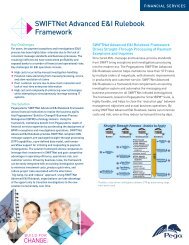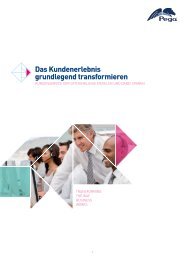On-boarding and Electronic Bank Account Management for ...
On-boarding and Electronic Bank Account Management for ...
On-boarding and Electronic Bank Account Management for ...
Create successful ePaper yourself
Turn your PDF publications into a flip-book with our unique Google optimized e-Paper software.
Market intelligence report – September 2009<strong>On</strong>-<strong>boarding</strong> <strong>and</strong> <strong>Electronic</strong><strong>Bank</strong> <strong>Account</strong> <strong>Management</strong><strong>for</strong> Corporate TreasuriesSponsored by:®<strong>On</strong>-<strong>boarding</strong> <strong>and</strong> <strong>Electronic</strong> <strong>Bank</strong> <strong>Account</strong> <strong>Management</strong> <strong>for</strong> Corporate Treasuries - 2009 © Finextra Research Limited
Market intelligence report – September 2009BackgroundPractices <strong>for</strong> account opening <strong>and</strong> management, at both corporates <strong>and</strong> banks, are still very manual <strong>and</strong>paper-based, creating an inefficient, error-prone environment. SWIFT <strong>and</strong> a small group of leading banks,corporates <strong>and</strong> IT vendors have been working to help address the problem through the development ofelectronic bank account management (EBAM) st<strong>and</strong>ards.In July <strong>and</strong> August 2009, Finextra <strong>and</strong> Pegasystems surveyed corporate treasuries <strong>and</strong> banks worldwide toestablish what the current pain points are around account management, what awareness there is of EBAM,what hurdles there are to greater st<strong>and</strong>ardisation <strong>and</strong> improvement, <strong>and</strong> what benefits are up <strong>for</strong> grabs.We received 43 survey responses from 39 banks, <strong>and</strong> 53 responses from 51 corporates, <strong>for</strong> a total of 96respondents.Among the corporates, 60% of respondents have an annual turnover higher than US$500m. 41% currentlymaintain more than 500 bank accounts <strong>and</strong> 44% deal with 11 different banks or more.Among the banks, 40% of banks operated in 11 countries or more, 63% had more than 1,000 corporatecustomers, <strong>and</strong> 51% managed more than 800,000 corporate customer accounts.Pegasystems in the financial services industryPegasystems has been providing business solutions to the financial services industry <strong>for</strong> over 23 years.Leading banks <strong>and</strong> financial services institutions work with Pegasystems to provide solutions <strong>for</strong> paymentinvestigations <strong>and</strong> SWIFT E&I, client on-<strong>boarding</strong> <strong>and</strong> electronic bank account management (EBAM), knowyour customer (KYC) <strong>and</strong> sanctions management. Pegasystems solutions are used by seven of the top tenglobal banks, <strong>and</strong> seven of the top ten credit card issuers. Pegasystems technology also supports 60% ofthe world’s payment investigations.Headquartered in Cambridge, MA, Pegasystems has offices in North America, Europe <strong>and</strong> Asia. Visit us atwww.pega.comAbout FinextraFinextra Research is the leading newswire <strong>and</strong> online community <strong>for</strong> the global financial technology industry,with 3 million page views <strong>and</strong> 110,000 unique visitors per month. More than 26,000 financial technologyprofessionals worldwide receive our free daily <strong>and</strong> weekly e-mail newsletters. Finextra additionally operatesits own conferences <strong>and</strong> exhibitions on a range of topics under the Finexpo br<strong>and</strong>, <strong>and</strong> collaborates with theEuro <strong>Bank</strong>ing Association to produce the annual pan- European payments conference EBAday. Finextra isalso the official online news vendor <strong>for</strong> Swift’s annual financial technology conference Sibos.Finextra additionally hosts an online professional networking <strong>and</strong> blogging service <strong>for</strong> the global financialtechnology industry – www.finextra.com/community2<strong>On</strong>-<strong>boarding</strong> <strong>and</strong> <strong>Electronic</strong> <strong>Bank</strong> <strong>Account</strong> <strong>Management</strong> <strong>for</strong> Corporate Treasuries - 2009 © Finextra Research Limited
Market intelligence report – September 2009Executive summaryIndustry initiatives to improve the customer experience <strong>and</strong> drive out cost from account opening <strong>and</strong>maintenance are still at a relatively early stage. Specifically, incorporating an easy to use EBAM st<strong>and</strong>ard tostreamline these activities is lagging. But there is plentiful pent-up dem<strong>and</strong> among corporatetreasurers to streamline these processes <strong>and</strong> add new channels by which they can engage their bankingprovider. <strong>Bank</strong>s that move quickly to build EBAM capability while aligning themselves with developingindustry st<strong>and</strong>ards will have a short-term competitive differentiator in the market.National regulatory compliance issues will continue to complicate ef<strong>for</strong>ts to streamline processes <strong>for</strong>companies that operate across borders. But effective investment in IT process improvement <strong>and</strong>st<strong>and</strong>ardisation can help banks simplify requirements <strong>for</strong> corporate customers while also delivering thespeed of service they desperately require.Key findings from the survey were:<strong>Account</strong> management is slow <strong>and</strong> inefficient, <strong>and</strong> corporates are dem<strong>and</strong>ing a better service• 60% of corporates say it currently takes them more than one week to open a new bank account.Even large multinationals are still largely reliant on manual processes when dealing with their banks,<strong>and</strong> are under-resourced.• 44% of corporates would switch banks <strong>for</strong> better service around account opening, maintenance<strong>and</strong> closing. In this competitive environment banks are at risk of losing customers or customer shareof wallet to banks that can meet the corporates’ needs.• A growing number (15%) of corporates expect all of their bank providers to offer EBAM services inthe short term <strong>and</strong> are adding it to all of their new RFPs.Process automation <strong>and</strong> st<strong>and</strong>ardisation around EBAM are challenging• 60% of corporate respondents said that legal differences <strong>and</strong> lack of st<strong>and</strong>ardisation were theirbiggest or second biggest challenge in streamlining the processes around bank accountmanagement. Those that chose this as their biggest challenge were almost exclusively corporatesthat have moved from having treasury operations in each country they operate to having severalregional centres or a single global treasury centre.• Most banks saw the lack of IT resources <strong>and</strong> technologies as the biggest obstacle to thembeing able to deliver timely EBAM services to their corporates. 60% saw this as the biggest orsecond biggest challenge. This is becoming an even bigger issue <strong>for</strong> banks as more <strong>and</strong> morecorporates are dem<strong>and</strong>ing service level agreements (SLAs) <strong>for</strong> account management activities.Already 57% of corporates have negotiated such SLAs.• 47% of banks believe that it would take more than a year to undertake the necessary process <strong>and</strong>system re-engineering to enable EBAM.Corporates will obviously benefit, but banks will also see a return on their investment• <strong>Bank</strong>s recognise that delivering EBAM services is a great opportunity to win new clients <strong>and</strong>maintain existing ones. 63% of banks believe it will help them win new clients.• <strong>Bank</strong>s also believe they can reduce their operational costs associated with account managementby an average of 21%.<strong>On</strong>-<strong>boarding</strong> <strong>and</strong> <strong>Electronic</strong> <strong>Bank</strong> <strong>Account</strong> <strong>Management</strong> <strong>for</strong> Corporate Treasuries - 2009 © Finextra Research Limited3
Market intelligence report – September 2009<strong>Account</strong> management is slow <strong>and</strong> inefficient, <strong>and</strong> corporatesare dem<strong>and</strong>ing a better serviceOpening new bank accounts <strong>and</strong> maintaining their lifecycles are all still verymanual processes <strong>for</strong> corporate treasuries. Particularly when a company isoperating across borders <strong>and</strong> dealing with multiple banks, it finds that themultitude of different legal <strong>and</strong> process requirements are placing a highburden on the few staff resources they have allocated to accountmanagement functions.Chart 1: Corporates - How manystaff focus on accountmanagement?14%The majority (52%) of corporate survey respondents had less than fourstaff in such roles (Chart 1). Not surprisingly the few well staffed companieswith more than 21 staff on board all had turnovers of more than $1 billion.But among those with less than four staff, there were also many such largecompanies. 46% of companies operating with less than four staff hadannual revenues greater than $1 billion, <strong>and</strong> on average companies with thisstaffing level had around 500 accounts open at any one time.In today’s online world, individual customers have come to expect rapidapplication <strong>and</strong> account opening from financial services firms. Many onlinedirect savings banks, <strong>for</strong> example, are able to open new customer accountsin less than 10 minutes.In the world of corporate banking, there are, of course, more complexrequirements <strong>for</strong> account opening. But even still, it is somewhatsurprising that <strong>for</strong> 60% of corporates it takes more than a week to opena new account (Chart 2). And <strong>for</strong> 40%, it takes a similar length of time tomake a simple change such as adding a new authorised person to theaccount.10%24%1-34-1011-2021+52%Chart 2: Elapsed average time to open/maintain/close a bank accountOpenCorp.<strong>Bank</strong>10% 6% 24% 29% 31%21% 28% 30% 14% 7%MaintainCorp.<strong>Bank</strong>31% 14% 15% 25% 15%40% 32% 26% 2%CloseCorp.<strong>Bank</strong>12% 12% 42% 13% 21%21% 30% 28% 7% 14%0 20 40 60 80 10042hrs
Market intelligence report – September 2009Interestingly, when asked the same question, banks were much moreoptimistic in their time frame estimates (Chart 2). It is likely that most wereonly taking into account the required activities taking place at the bank, <strong>and</strong>not the in<strong>for</strong>mation gathering <strong>and</strong> <strong>for</strong>m filling required by the customer aspart of the total process. Even still, the majority (51%) of banks said it tookthem more than two days to open an account.The biggest disconnect between banks <strong>and</strong> corporates was the time ittakes <strong>for</strong> a maintenance activity. 40% of corporates said this took themmore than a week, compared to just 2% of banks.As a result of the complex environment they’re operating in, <strong>and</strong> lack ofresources, the survey revealed that corporates are increasingly turning totheir banks <strong>for</strong> help. Such is their current pain that 44% of corporates saidthey would be willing to switch banks to get better service, st<strong>and</strong>ardisation<strong>and</strong> automation <strong>for</strong> account management processes (Chart 3).Switching may not mean cutting off a bank completely, but even if acorporate shifts just some of their business elsewhere <strong>for</strong> better service,banks can risk losing share of wallet among customers <strong>and</strong> even marketshare in an increasingly competitive environment.Chart 3: Corporates - Would youconsider switching to a differentbank <strong>for</strong> better accountmanagement capabilities?56% 44%yesnoThe propensity to switch is despite the fact that stringent know yourcustomer (KYC) compliance requirements <strong>and</strong> other new client proceduresare themselves a significant barrier to switching to a new bank.<strong>On</strong>-<strong>boarding</strong> <strong>and</strong> <strong>Electronic</strong> <strong>Bank</strong> <strong>Account</strong> <strong>Management</strong> <strong>for</strong> Corporate Treasuries - 2009 © Finextra Research Limited5
Market intelligence report – September 2009Awareness <strong>and</strong> dem<strong>and</strong> <strong>for</strong> EBAMWhile there are challenges in automating processes in such a complexenvironment, the majority of corporates have started to adopt some levelof systemised support <strong>for</strong> account management. <strong>On</strong>ly 30% of respondentssaid that they are still operating in a completely manual environment (Chart5). For this particular question respondents were free to select any or nostatements to agree with.Most corporates have some underst<strong>and</strong>ing <strong>and</strong> awareness of EBAM,whether it’s from media <strong>and</strong> trade associations, SWIFT’s outreach about itsst<strong>and</strong>ardisation ef<strong>for</strong>ts, or sales teams from some of the leading banks. <strong>On</strong>ly21% claimed no awareness. And a growing number (15%) are beginning toexpect such services from all their banks.In fact, when banks were asked about RFPs, 79% of them said they haveseen EBAM requirements in RFPs from potential customers at least44sometimes, with 32% of all banks saying that this has become a frequentrequest (Chart 4).This demonstrates that as the corporate transaction banking environmentbecomes increasingly competitive, with top corporates more likely to cherrypick <strong>and</strong> switch banks, that EBAM capabilities are gradually becoming ast<strong>and</strong>ard industry requirement.Chart 4: <strong>Bank</strong>s - How often doyou see automated on-<strong>boarding</strong><strong>and</strong> management services inRFPs?21%Not at allSometimesFrequently47%32%Chart 5: Corporate approach to automated electronic bank account management (EBAM)We've done some internal work toautomate account management,but are missing the link with our banks9%We've heard about some of the work beingdone to improve st<strong>and</strong>ardisation <strong>and</strong> automationin account management, <strong>and</strong> are interestedin finding out more13%We view it as an optional extra,<strong>and</strong> are hoping to see it offeredby some of our bank providers15%We expect all of our bank providersto offer EBAM services in the short term<strong>and</strong> are adding it to all new RFPs15%We're not aware of any EBAM initiatives21%Our account managementprocesses are still fully manual30%60 5 10 15 20 25 30<strong>On</strong>-<strong>boarding</strong> <strong>and</strong> <strong>Electronic</strong> <strong>Bank</strong> <strong>Account</strong> <strong>Management</strong> <strong>for</strong> Corporate Treasuries - 2009 © Finextra Research Limited
Market intelligence report – September 2009Process automation <strong>and</strong> st<strong>and</strong>ardisation around EBAMare challengingHaving established that account management activities take muchlonger than corporates would like, we investigated the wider challengesthey face to find some reasons why. The number one reason was the lackof st<strong>and</strong>ardisation. Currently, account management processes are h<strong>and</strong>leddifferently by every bank, <strong>and</strong> are tailored to specific legal requirements ineach country or region. Faced with this duplication of often incompatibleprocesses, it can be a challenge to implement best practices <strong>for</strong> streamlinedoperation, <strong>and</strong> it is also a challenge to increase automation through the useof in<strong>for</strong>mation technology.60% of corporate respondents said that legal differences <strong>and</strong> lack ofst<strong>and</strong>ardisation were their biggest or second biggest challenge (Chart 6).Those that chose this as their biggest challenge were almost exclusivelycorporates that have moved from having treasury operations in eachcountry they operate to having several regional centres or a single globaltreasury centre.M<strong>and</strong>ate management, keeping track of who has the m<strong>and</strong>ate to do whaton which account, was collectively seen as another pressing issue, with54% viewing this is the biggest or second biggest challenge they face. Thisfigure maps well with the 55% of corporates who said that a single accountmaintenance action (e.g. amending a m<strong>and</strong>ate) with their banks took morethan two days on average (Chart 2).Chart 6: Corporate challenges in bank account managementMultiple legal jurisdictions make governance<strong>and</strong> st<strong>and</strong>ardisation of processes difficult47% 13% 8% 16% 16%M<strong>and</strong>ate management16% 38% 17% 13% 16%Cost of staff required to manually maintain accounts15% 18% 19% 24% 24%Digital identity management/authentication13% 13% 22% 10% 42%Inefficient processes increase our exposure to fraud9% 25% 25% 19% 22%0 20 40 60 80 1001-biggest challenge 2 3 4 5- least challenge<strong>On</strong>-<strong>boarding</strong> <strong>and</strong> <strong>Electronic</strong> <strong>Bank</strong> <strong>Account</strong> <strong>Management</strong> <strong>for</strong> Corporate Treasuries - 2009 © Finextra Research Limited7
Market intelligence report – September 2009Investment <strong>and</strong> hurdles to implementation <strong>and</strong> adoptionGiven the dem<strong>and</strong> from corporates <strong>for</strong> EBAM services it is interesting totake a look at how banks are currently positioned <strong>and</strong> how many arecurrently involved in projects to improve their capabilities <strong>and</strong> industryst<strong>and</strong>ardisation. Around 13 banks worldwide have already beenparticipating in the EBAM working group <strong>and</strong> pilot program with SWIFT onthe new EBAM st<strong>and</strong>ard, <strong>and</strong> six of these participated in the survey.Across all bank participants, 47% have made plans to invest in improvingclient on-<strong>boarding</strong> of new accounts <strong>and</strong> maintenance (Chart 7). But giventhe level of dem<strong>and</strong> from corporates, it is perhaps surprising that 53% havenot yet made any plans to invest in IT <strong>and</strong> automation. Those that did planto invest tended to be larger <strong>and</strong> included many of the survey participantsfrom the US, UK <strong>and</strong> the Netherl<strong>and</strong>s.Those without plans to invest spanned a wide range of sizes of banks <strong>and</strong>countries. This is important especially in light of the fact that 57% ofcorporates said they have negotiated service-level agreements (SLAs) withtheir banks. To be able to respond to these SLAs banks simply mustautomate these processes <strong>and</strong> make their customer service highly efficient.Chart 7: <strong>Bank</strong>s - When will youinvest in IT to improve <strong>and</strong>automate on-<strong>boarding</strong> <strong>and</strong>account management?53%2009201026%21%no concrete plans yetChart 8: Corporate roadblocks to simplifying/automating bank account managementCountry regulations still imposetoo much use of paper based documentation44% 16% 12% 12% 16%Different practices in each financial institution32% 29% 16% 10% 13%Lack of bank appetite dueto compliance <strong>and</strong> risk concerns19% 16% 37% 19% 9%Integration issues with our HR, GL<strong>and</strong> treasury management systems6% 9% 19% 41% 25%Unfamiliarity with SWIFT <strong>and</strong> st<strong>and</strong>ards9% 3% 19% 25% 44%0 20 40 60 80 1001-biggest roadblock2345- least roadblock8<strong>On</strong>-<strong>boarding</strong> <strong>and</strong> <strong>Electronic</strong> <strong>Bank</strong> <strong>Account</strong> <strong>Management</strong> <strong>for</strong> Corporate Treasuries - 2009 © Finextra Research Limited
Market intelligence report – September 2009Some investment will obviously be required, <strong>and</strong> in fact most banks saw thelack of IT resources <strong>and</strong> technologies as the biggest obstacle to them beingable to deliver EBAM services to their corporate customers. 60% saw thisas the biggest or second biggest challenge (Chart 10).Chart 9: <strong>Bank</strong>s - How long will ittake to re-engineer processes<strong>and</strong> systems to offer EBAM toclients?But <strong>for</strong> both banks <strong>and</strong> corporates, national <strong>and</strong> regional legal differences<strong>and</strong> requirements <strong>for</strong> paper-based processes are a significant barrier (Chart8). Any industry ef<strong>for</strong>ts to streamline <strong>and</strong> st<strong>and</strong>ardise EBAM will have tocontinue to address this challenge through dialogue with regulators.18%12%A contributing factor to IT resources being identified as the biggest hurdleto delivering EBAM services is that almost half of banks (47%) believe thatit would take more than a year to undertake the necessary process <strong>and</strong>system re-engineering (Chart 9).Those that have already begun investing in EBAM delivery, however, tendedto expect a shorter time frame of 7-12 months, with several quite largebanks even saying it could be done in as little as 3-6 months.29%18 months+13-18 months41%7-12 months3-6 monthsChart 10: <strong>Bank</strong> hurdles to embracing electronic on<strong>boarding</strong> <strong>and</strong> account managementAvailability of IT resources <strong>and</strong> technologiesto create service offering (e.g digital identity),integrate with internal processes<strong>and</strong> systems, <strong>and</strong> support clients33% 27% 20% 13% 7%Country regulations still impose toomuch use of paper based documentation27% 53% 13% 7%Predicting ROI <strong>and</strong> getting budget<strong>for</strong> process re-engineering project13% 33% 21% 13% 20%Getting buy-in from all relevantentities in global financial group13% 33% 40% 7% 7%Lack of corporate appetite <strong>for</strong>removing paper-based processes40% 33% 7% 20%0 20 40 60 80 1001- biggest 2 3 4 5- least<strong>On</strong>-<strong>boarding</strong> <strong>and</strong> <strong>Electronic</strong> <strong>Bank</strong> <strong>Account</strong> <strong>Management</strong> <strong>for</strong> Corporate Treasuries - 2009 © Finextra Research Limited9
Market intelligence report – September 2009Benefits to banks of EBAMWhen asked what potential benefits they could gain from offering EBAMservices, winning new corporate clients was seen as the most important(Chart 12). Given the growing frequency of requests in RFPs (Chart 5), itseems that this is a ripe opportunity right now, even though not manyinstitutions are well progressed in being able to deliver.Improving customer loyalty <strong>and</strong> reducing churn is the flipside of the samedriver to maintain <strong>and</strong> grow the transaction banking business. But anotherconsideration <strong>for</strong> banks is the cost associated with serving thous<strong>and</strong>s, oreven tens of thous<strong>and</strong>s, of clients – each with multiple accounts – inanything other than a fully automated environment.Chart 11: <strong>Bank</strong>s - With betteraccount management automation,by how much could you reduceassociated operational costs?31%7%31%This will obviously be reduced if EBAM can deliver to a bank similarprocessing efficiencies to those it is passing on to its clients. Estimates onoperational cost savings varied quite widely. But, on average, banksexpected to reduce costs directly associated with account opening,maintaining <strong>and</strong> closing by 21% (Chart 11).41%+31%10-20%31-40%
Market intelligence report – September 2009SummaryCorporates have a lot to gain if their banks can provide effective EBAM services. <strong>Bank</strong>s too st<strong>and</strong> to boosttheir competitiveness <strong>and</strong> market share if they can build <strong>and</strong> market their capabilities around on-<strong>boarding</strong><strong>and</strong> account management.<strong>Bank</strong>s that are investing in this area in 2009 <strong>and</strong> 2010 will be well placed to benefit rapidly from developingindustry st<strong>and</strong>ards <strong>and</strong> burgeoning corporate dem<strong>and</strong>. But with the right approach to processre-engineering, other banks should also be able relatively quickly to add EBAM to their service portfolio asthe market matures.“When we’re evaluating our banking relationships, we absolutely give preferenceto banks that can meet SLAs <strong>for</strong> account management activity.”Treasurer at IT company“We haven’t really heard much about EBAM. And we’re still pretty much manual in ourprocesses. But we would consider switching business to a bank that can address ourproblems in this area, as long as it also meets our other requirements.”Senior financial consultant, food <strong>and</strong> beverage company“Some of our banks have made ef<strong>for</strong>ts to streamline account management.And it helps. But we deal with a lot of banks. Until EBAM services are morewidespread, <strong>and</strong> there are industry st<strong>and</strong>ards <strong>for</strong> processes <strong>and</strong> messages,we won’t really see the true benefit.”Cash manager at pharmaceutical company<strong>On</strong>-<strong>boarding</strong> <strong>and</strong> <strong>Electronic</strong> <strong>Bank</strong> <strong>Account</strong> <strong>Management</strong> <strong>for</strong> Corporate Treasuries - 2009 © Finextra Research Limited 11
Market intelligence report – September 2009About PegasystemsPegasystems, the leader in Business Process <strong>Management</strong>, provides software to driverevenue growth, productivity <strong>and</strong> agility <strong>for</strong> the world’s most sophisticated organizations.Customers use our award-winning SmartBPM® suite to improve customer service, reachnew markets <strong>and</strong> boost operational effectiveness.Our patented SmartBPM® technology makes enterprise applications easy to build <strong>and</strong>change by directly capturing business objectives <strong>and</strong> eliminating manual programming.SmartBPM® unifies business rules <strong>and</strong> processes into composite applications that leverageexisting systems – empowering businesspeople <strong>and</strong> IT staff to Build <strong>for</strong> Change®,deliver value quickly <strong>and</strong> outper<strong>for</strong>m their competitors.Pegasystems’ suite is complemented by best-practice frameworks designed <strong>for</strong> leadersin financial services, insurance, healthcare, government, life sciences, communications,manufacturing <strong>and</strong> other industries.Headquartered in Cambridge, MA, Pegasystems has offices in North America, Europe<strong>and</strong> Asia. Visit us at www.pega.com.®<strong>On</strong>-<strong>boarding</strong> <strong>and</strong> <strong>Electronic</strong> <strong>Bank</strong> <strong>Account</strong> <strong>Management</strong> <strong>for</strong> Corporate Treasuries - 2009 © Finextra Research Limited
















